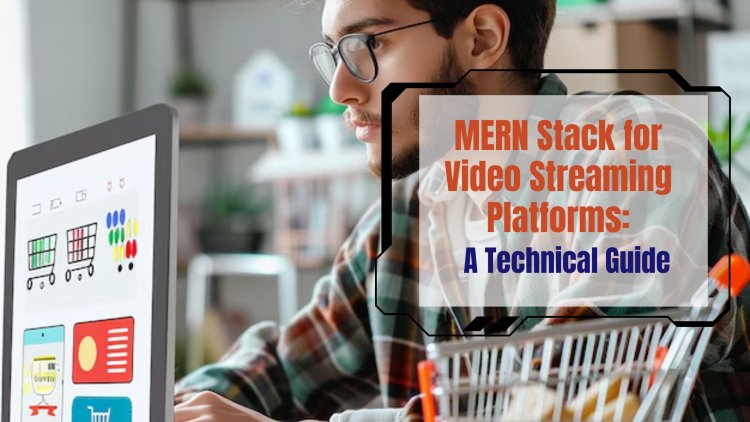MERN Stack for Video Streaming Platforms: A Technical Guide
Share this Post to earn Money ( Upto ₹100 per 1000 Views )

Video streaming platforms have taken the world by storm, powering everything from entertainment services like Netflix and YouTube to business applications like webinars and corporate training. As users demand more personalized, high-quality, and seamless video experiences, businesses and developers are turning to powerful tech stacks to build scalable, real-time applications. One such stack that has emerged as a game-changer for video streaming platforms is the MERN stack.
In this technical guide, we will explore how the MERN stack (MongoDB, Express.js, React.js, and Node.js) can be leveraged for building video streaming platforms. We will dive into the technicalities, explore key features, and understand why this tech stack is perfect for handling the unique demands of video streaming applications. Additionally, we will also discuss the importance of collaborating with the best MERN Stack development company and Video Streaming App Development Company to achieve an optimal solution.
Understanding the MERN Stack
The MERN stack is a powerful collection of JavaScript-based technologies used to build modern web applications. It consists of four primary components:
-
MongoDB: A NoSQL database that stores data in a flexible, JSON-like format, allowing for easy storage and retrieval of large amounts of data.
-
Express.js: A lightweight and flexible Node.js framework that simplifies the process of building web applications and APIs.
-
React.js: A popular JavaScript library developed by Facebook, used for building dynamic and interactive user interfaces. React’s component-based architecture is especially suited for creating rich front-end experiences.
-
Node.js: A runtime environment that allows JavaScript to be run server-side. Node.js is known for its high scalability and ability to handle multiple requests simultaneously, which is essential for high-traffic applications like video streaming platforms.
Together, these technologies enable developers to build full-stack web applications using a single programming language—JavaScript. This unification makes the development process more efficient and streamlined, offering speed and flexibility.
Why Choose MERN Stack for Video Streaming Platforms?
Video streaming applications come with their own set of challenges: large media files, real-time data processing, high traffic, smooth user interfaces, and more. The MERN stack addresses these challenges effectively due to its flexibility, scalability, and real-time processing capabilities. Below are some reasons why the MERN stack is ideal for video streaming platforms:
1. Scalability
Video streaming platforms must be able to handle massive amounts of data, including high-resolution videos, and support millions of simultaneous viewers. The Node.js runtime, built on the V8 JavaScript engine, is highly scalable, allowing video streaming applications to handle high traffic efficiently. Moreover, MongoDB is a NoSQL database that stores data in JSON-like format, which is ideal for handling large, unstructured data like video metadata, user preferences, and comments.
2. Real-Time Streaming and WebSocket Support
Real-time interaction is critical in video streaming platforms, especially for live streaming features, user engagement (comments, chats), and on-demand video playback. Node.js supports WebSocket, a communication protocol that enables real-time, two-way communication between the client and the server. This allows for seamless streaming and instant communication, ensuring that users enjoy real-time content without significant buffering or delays.
3. Efficient Video Transcoding and Streaming
Express.js and Node.js can be used to build efficient back-end systems that handle video transcoding (converting video files into different formats) and streaming. For instance, video files uploaded by users can be processed and converted into multiple formats (MP4, WebM, etc.), allowing for compatibility across various devices. Additionally, Express.js makes it easy to handle requests and send data to clients quickly, ensuring that videos stream smoothly without latency.
4. Rich User Interface with React.js
The front-end of a video streaming platform plays a crucial role in the user experience. React.js, with its component-based architecture, allows developers to build reusable UI components, such as video players, thumbnails, and playlists. This results in a responsive, interactive, and dynamic interface that ensures smooth user interactions.
5. Unified JavaScript Development
Using JavaScript across both the client and server sides simplifies the development process and reduces the need for context switching between different programming languages. This unified approach makes it easier to maintain and debug the code, improving overall productivity and efficiency.
6. Cost-Effectiveness and Speed
The MERN stack is open-source, meaning developers can build and deploy applications without significant licensing costs. Moreover, with the support of a vast number of libraries and frameworks, MERN enables rapid development. This is particularly valuable for video streaming platforms that require quick iterations and constant feature updates to stay competitive.
Key Features of Video Streaming Platforms Built with MERN Stack
Here are some key features that can be implemented in a video streaming platform using the MERN stack:
1. User Authentication and Authorization
A video streaming platform requires user authentication to manage subscriptions, preferences, and watch history. Node.js and Express.js can be used to build secure authentication systems using popular strategies such as JWT (JSON Web Tokens) or OAuth. This ensures that user data and preferences are protected.
2. Video Upload and Management
Users need the ability to upload videos, which requires the platform to handle large media files efficiently. MERN stack can facilitate this through Express.js, which handles file uploads using modules like Multer. Additionally, MongoDB can store metadata such as video titles, descriptions, upload dates, and user IDs, providing an efficient way to manage video content.
3. Video Streaming and Playback
Once videos are uploaded, they need to be served to users. Node.js can be used to implement efficient video streaming protocols (HLS, DASH) and ensure smooth playback across different devices. React.js can be used to implement custom video players with features like play, pause, rewind, and full-screen modes.
4. Real-Time Chat and Comments
To increase user engagement, Node.js and WebSockets allow for real-time features such as live chat during video streaming. For instance, users can interact with each other during live events or leave comments on recorded videos. This real-time communication feature enhances the social aspect of video streaming.
5. Search and Recommendation Systems
MERN allows developers to integrate powerful search functionality that enables users to find specific videos or channels easily. Additionally, using machine learning techniques, developers can implement recommendation engines that suggest videos based on user preferences, watch history, and behavior.
6. Adaptive Streaming
For a smooth video streaming experience, adaptive streaming is essential. It allows the video quality to automatically adjust based on the user’s internet connection. Using protocols like HLS (HTTP Live Streaming) or DASH (Dynamic Adaptive Streaming over HTTP), developers can ensure users receive the best quality stream possible without interruptions.
7. Subscription and Monetization
A typical video streaming platform may offer tiered subscriptions with different levels of access to content. MERN allows developers to integrate payment gateways and manage user subscriptions securely. This can include video paywalls, ad-supported free versions, or premium membership tiers.
Steps to Build a Video Streaming Platform with MERN Stack
1. Setting Up the Environment
Begin by setting up a development environment with Node.js and MongoDB. Install Express.js to handle API requests and React.js for the front-end.
2. Video Upload and Storage
For video uploads, integrate cloud storage services like AWS S3 or Google Cloud Storage. The uploaded videos can be transcoded using FFmpeg or similar tools before they are stored.
3. Database Design
Design a database schema for MongoDB that includes collections for users, videos, comments, likes, subscriptions, and other necessary data points. MongoDB’s flexibility allows you to handle different data types and large video metadata easily.
4. Implement Real-Time Features
Set up WebSocket using Socket.io for real-time chat and live interactions during video streaming. This will allow users to interact with each other in real-time.
5. Integrate Video Streaming Protocols
Implement video streaming protocols such as HLS or DASH using Node.js to serve video content to users seamlessly. Use libraries like Video.js or JWPlayer to embed video players in your React components.
6. Build and Optimize the Front-End
Use React.js to create dynamic UI components such as video players, search bars, and user profiles. Optimize your React components to handle large-scale data and ensure fast loading times.
7. Security and Authentication
Implement secure authentication using JWT for managing user sessions. You can also integrate OAuth for third-party logins and ensure the security of sensitive user data.
8. Deploy and Monitor
Once your video streaming platform is built, deploy it using cloud services such as AWS, Heroku, or Google Cloud. Monitor your platform’s performance using Google Analytics and New Relic to track real-time usage and ensure everything runs smoothly.
Benefits of Partnering with the Best Video Streaming App Development Company
Building a video streaming platform using MERN stack can be complex, and for businesses that lack the technical expertise, partnering with a Video Streaming App Development Company is the best solution. These companies specialize in building scalable, secure, and high-performance platforms. Their expertise allows businesses to focus on content creation, marketing, and user engagement while leaving the technical heavy-lifting to experts.
By working with a mobile app development company that has experience in MERN stack development, you can ensure that your platform is optimized for both desktop and mobile devices, providing a seamless experience across all screen sizes.
Conclusion
The MERN stack offers an excellent foundation for building modern, scalable, and real-time video streaming platforms. By combining the flexibility and scalability of MongoDB, Express.js, React.js, and Node.js, developers can create seamless video streaming experiences that can handle millions of users, provide real-time interaction, and support adaptive streaming.
Partnering with the best MERN Stack development company and a Video sharing app development can help businesses build customized video platforms that meet their unique needs while ensuring high performance, security, and scalability.















